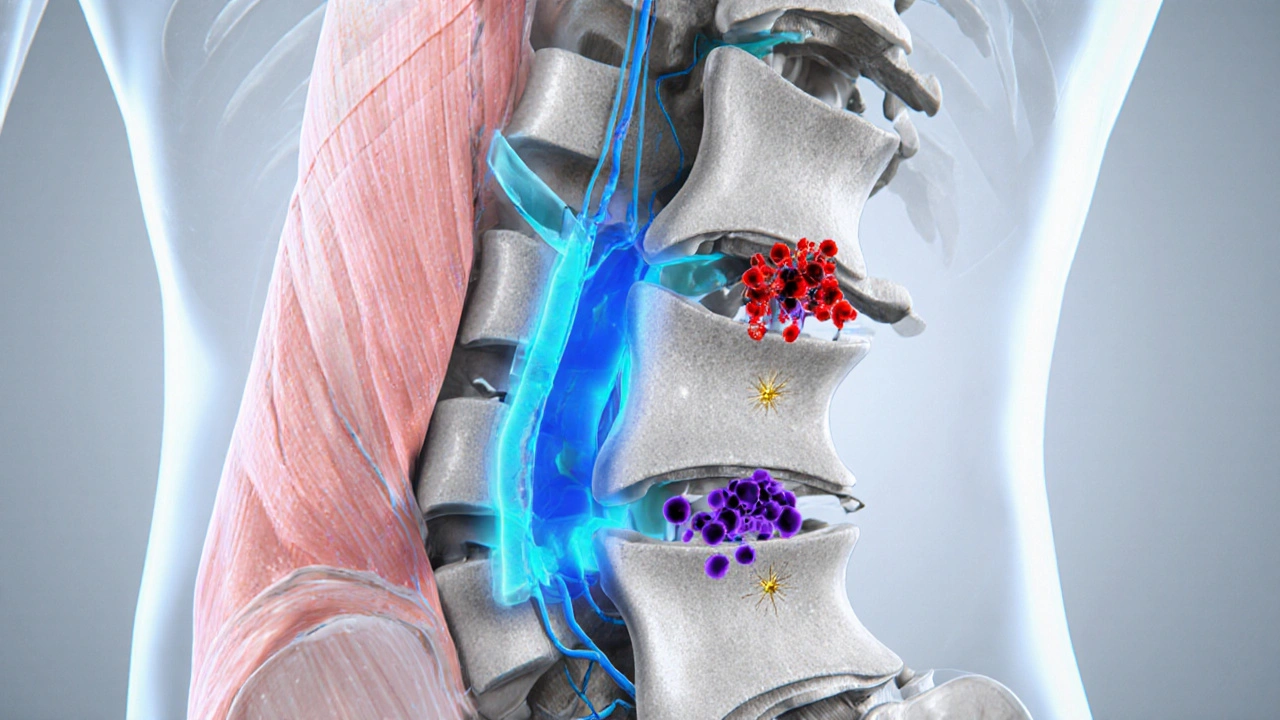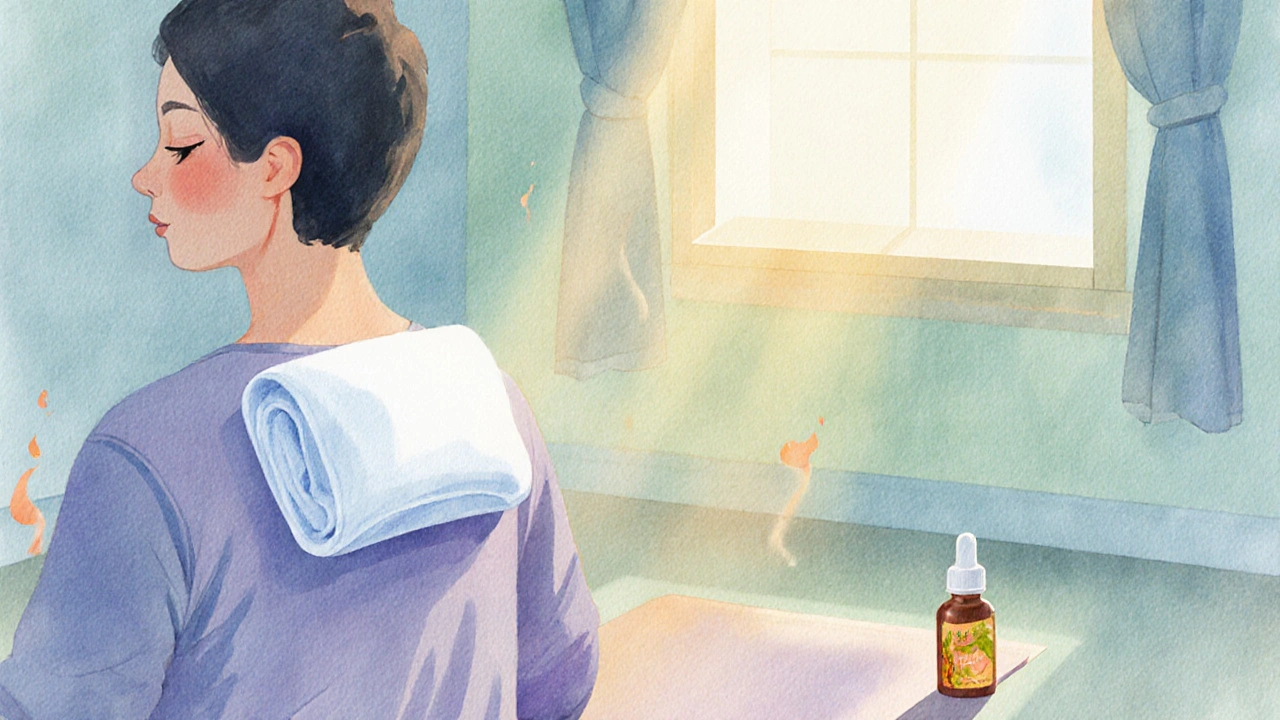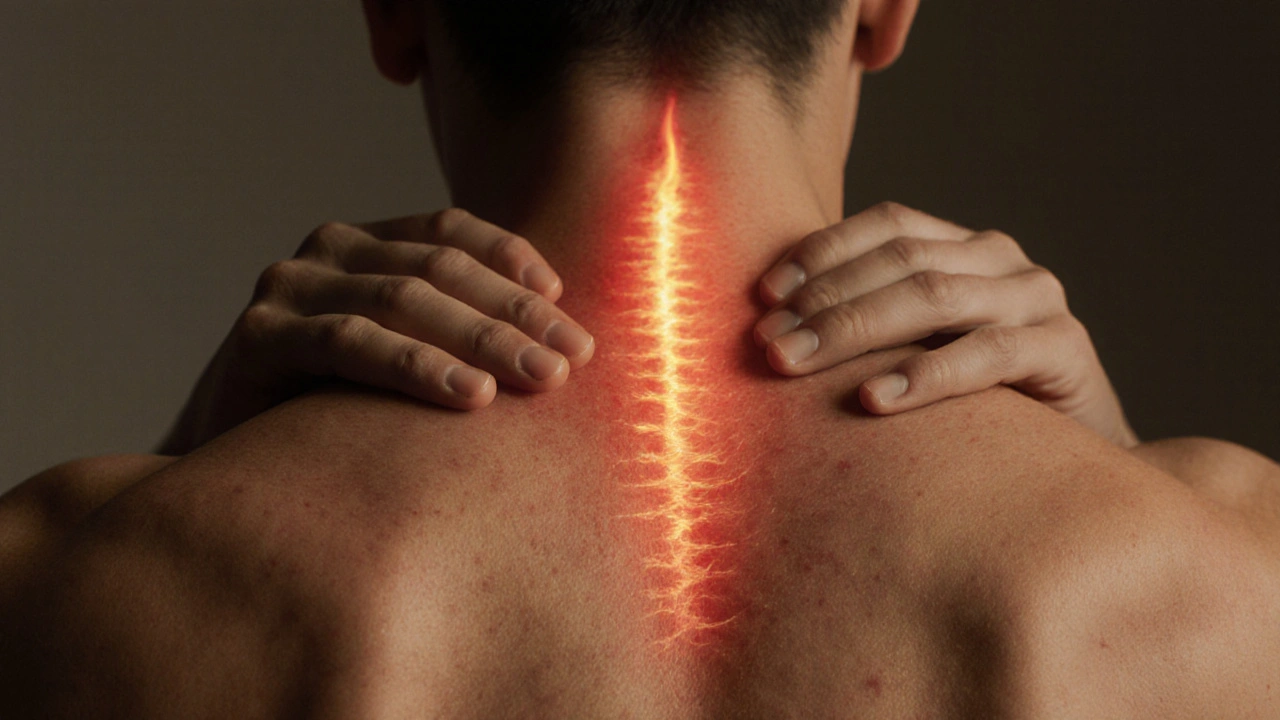Back Burning Sensation Symptom Checker
Potential Causes Based on Your Symptoms
Answer the questions and click "Analyze My Symptoms" to see possible causes.
Feeling like a hot iron is crawling across your back can be alarming. It’s not just a fleeting itch-this burning sensation may signal anything from a pinched nerve to a skin infection. Below you’ll find a clear rundown of why it happens, when to call a doctor, and what you can do right now to soothe the heat.
What Is a Burning Sensation in the Back?
Burning sensation in the back is a subjective feeling of heat, tingling, or pins‑and‑needles that originates from the skin, muscles, or nerves along the spine. Unlike regular muscle soreness, the pain often feels sharp, electric, or like a flame moving up and down. It can be constant or come in waves, and it may worsen with certain movements, temperature changes, or pressure.
Common Causes
Understanding the source helps you target the right treatment. Here are the most frequent culprits:
- Pinched Nerve (e.g., sciatica) - When a spinal nerve is compressed, the brain interprets the pressure as burning. Typical triggers include herniated discs or spinal stenosis.
- Peripheral Neuropathy - Damage to peripheral nerves, often from diabetes or chronic alcohol use, produces a burning, numb feeling that can start in the back and travel outward.
- Shingles (Herpes Zoster) - A reactivation of the chickenpox virus that creates a painful, blistering rash, usually confined to one nerve segment.
- Muscle Strain or Overuse - Intense or repetitive activity can inflame muscle fibers, leading to a hot, burning ache that mimics nerve pain.
- Dermatitis or Heat Rash - Skin inflammation from allergens, sweat, or prolonged heat exposure can cause localized burning.
- Vitamin B12 Deficiency - Lacking B12 impairs nerve myelination, resulting in tingling and burning sensations, often first noticed in the back.
- Medication Side Effects - Certain drugs, like some chemotherapy agents or statins, may induce neuropathic pain manifesting as a burning back.
Spotlight on Key Players
Sciatica is a specific type of nerve compression that radiates from the lower back down the leg. It’s caused by a herniated disc or bone spur pressing on the sciatic nerve.
Shingles occurs when the varicella‑zoster virus awakens in a dorsal root ganglion, producing a painful, burning rash that follows a dermatomal pattern.
Peripheral neuropathy describes widespread nerve damage, often linked to diabetes, that yields burning, tingling, or numbness in the extremities and back.
Muscle strain refers to microscopic tears in muscle fibers caused by overstretching or excessive load, leading to inflammation and a hot ache.
Dermatitis is an inflammatory skin condition triggered by irritants, allergens, or heat, resulting in redness, itching, and a burning feel.
Vitamin B12 deficiency impairs nerve function, often producing a burning sensation that starts in the back and spreads to the limbs.
Medication‑induced neuropathy can arise from drugs that affect nerve health, creating a persistent, burning pain.

When to Seek Medical Help
If the burning persists more than a few days, is accompanied by weakness, loss of bladder control, or a spreading rash, call a healthcare professional immediately. These signs may indicate serious conditions like spinal cord compression or an infection that needs urgent treatment.
Treatment Options
Below is a tiered approach, starting with self‑care and moving to professional interventions.
- Self‑Care Measures
- Apply a cool compress for 15‑20 minutes several times a day to reduce heat.
- Gentle stretching or yoga poses that lengthen the back muscles can ease nerve pressure.
- Over‑the‑counter NSAIDs (e.g., ibuprofen 400mg) taken with food may lower inflammation.
- Stay hydrated and avoid excessive caffeine, which can heighten nerve excitability.
- Prescription Medications
- Gabapentin or pregabalin are first‑line for neuropathic pain; start low and titrate as directed.
- Topical lidocaine 5% patches provide localized numbing without systemic side effects.
- For shingles, antiviral agents such as acyclovir 800mg five times daily for 7days can shorten the course and lessen pain.
- Physical Therapy
- Targeted exercises improve spinal alignment and relieve nerve compression.
- Manual therapy, such as soft‑tissue mobilization, can break up adhesions causing burning muscle pain.
- Procedural Interventions
- Epidural steroid injections reduce inflammation around compressed nerves.
- In refractory cases, a nerve block or radiofrequency ablation may be recommended.
- Address Underlying Deficiencies
- Blood tests for B12, folate, and glucose can reveal hidden causes.
- Supplementation with methylcobalamin 1000µg daily can reverse B12‑related burning sensations within weeks.
Preventive Lifestyle Tips
Adopting a few habits can keep the back cool and pain‑free:
- Maintain a healthy weight to lessen spinal load.
- Incorporate regular low‑impact cardio (walking, swimming) to improve circulation.
- Use ergonomic furniture; keep monitors at eye level to avoid slouching.
- Dress in breathable fabrics during summer to prevent heat rash.
- Schedule annual health checks to monitor blood sugar and vitamin levels.
Quick Reference Checklist
| Cause | Typical Symptoms | When to See a Doctor |
|---|---|---|
| Pinched nerve (sciatica) | Sharp burning down leg, worsens with coughing | Weakness, loss of bladder control |
| Shingles | Band‑like rash, fever, tingling before blisters appear | Rash spreads or pain persists >2 weeks |
| Peripheral neuropathy | Burning + numbness in both sides, often feet first | Blood sugar out of control, sudden worsening |
| Dermatitis / heat rash | Red patches, itching, heat‑induced sweat | Signs of infection (pus, spreading redness) |
| Vitamin B12 deficiency | Burning + tingling, pale skin, fatigue | Anemia signs, persistent symptoms despite diet |

Frequently Asked Questions
Can a burning sensation be a sign of something serious?
Yes. If the feeling is accompanied by weakness, loss of bladder or bowel control, or a spreading rash, it could indicate spinal cord compression, infection, or a neurologic emergency that needs prompt evaluation.
How long does shingles‑related burning usually last?
With antiviral treatment started within 72hours, the rash typically clears in 2‑3weeks and the burning subsides. Without treatment, pain can linger for months (post‑herpetic neuralgia).
Are over‑the‑counter creams effective for a burning back?
Topical lidocaine or capsaicin can help when the cause is nerve‑related. For pure skin irritation, soothing aloe or hydrocortisone creams reduce heat and itching.
What lifestyle changes lower the risk of neuropathic burning?
Keep blood sugar stable, avoid excessive alcohol, eat B12‑rich foods (meat, fortified cereals), stay active, and maintain a healthy weight to reduce spinal pressure.
When is it appropriate to use heat therapy?
Heat can relax tight muscles after the acute burning phase has passed (usually after 48‑72hours). Applying a warm pack for 15minutes helps increase blood flow and eases stiffness.

7 Comments
lorna Rickwood
October 4 2025
Life is a tapestry of sensations and that burning feeling on your back is just another thread tugging at our awareness. It whispers that something is amiss yet it also invites us to reflect on the fragility of the body. Perhaps the nerves are simlpy echoing the stress of modern life, a reminder that we cannot ignore the signals our flesh sends us.
Consider pausing, breathing, and listening to what that heat truly means.
Mayra Oto
October 14 2025
The article does a solid job listing common culprits like sciatica, shingles and neuropathy, and the treatment hierarchy is clear. I appreciate the inclusion of lifestyle tips; they’re often overlooked in clinical write‑ups. For anyone juggling work and family, the simple stretches and ergonomic advice are especially useful.
S. Davidson
October 25 2025
You seem to think that reading a web page replaces a real medical appointment, which is a dangerous oversimplification. First, the list of causes is accurate, but you gloss over the fact that many of these conditions have overlapping symptoms, making self‑diagnosis a minefield. Second, the recommendation to “apply a cool compress” is fine for superficial irritation but totally useless for something like spinal cord compression. Third, suggesting over‑the‑counter NSAIDs without discussing contraindications ignores the reality that many patients have gastrointestinal issues or kidney disease. Fourth, the mention of gabapentin is correct yet you fail to warn about its sedative side effects and the need for dose titration. Fifth, the antiviral regimen for shingles is placed after “self‑care,” whereas early initiation is actually critical to prevent post‑herpetic neuralgia. Sixth, you list B12 supplementation but you don’t explain that oral methylcobalamin is preferred over cyanocobalamin in certain neurologic cases. Seventh, the lifestyle section encourages “low‑impact cardio” but neglects strength training, which is essential for spinal support. Eighth, you advise “stay hydrated and avoid excessive caffeine,” yet you never address alcohol consumption, a common neuropathy trigger. Ninth, the table is helpful, but the “When to See a Doctor” column is too vague – “weakness” could mean mild fatigue or actual motor loss. Tenth, the disclaimer at the top is appropriate, yet the tone of the article feels more like a sales pitch for supplements than an unbiased guide. Eleventh, the use of jargon like “dermatomal pattern” without clear definition may confuse lay readers. Twelfth, the article could benefit from a brief section on red‑flag symptoms that demand emergency care, such as sudden onset of bladder dysfunction. Thirteenth, you mentioned “erythema” in the dermatitis bullet but never explained how to differentiate it from infection. Fourteenth, the advice to “use ergonomic furniture” is good, but recommending specific products would turn the piece into advertising. Fifteenth, the concluding checklist repeats information already covered, offering little added value. Overall, while the content is not wrong, its presentation is sloppy and could mislead vulnerable readers into a false sense of security.
Haley Porter
November 4 2025
From a neurophysiological standpoint, the burning phenomenon can be conceptualized as ectopic discharges within the dorsal horn, modulated by peripheral sensitization and central hyperexcitability. When a lumbar root undergoes compression, the resultant demyelination facilitates ectopic impulse generation, which the patient perceives as a conflagration along the somatotopic map. In the case of herpes zoster, the viral reactivation triggers a vesicular eruption that aligns with a specific dermatomal distribution, mediated by retrograde axonal transport of viral particles. Moreover, metabolic derangements, such as B12 deficiency, impair methylmalonyl‑CoA conversion, leading to suboptimal myelin synthesis and subsequent neuropathic pain. Clinically, differentiating nociceptive versus neuropathic etiologies hinges on the temporal profile, associated dysesthesias, and response to analgesic modalities.
yash Soni
November 14 2025
Oh sure, just slap a cold pack on it and call it solved-because nothing says “effective treatment” like ignoring the real problem and hoping it disappears. Typical.
Emily Jozefowicz
November 25 2025
Nice rundown, but let’s be real: “apply a cool compress” won’t fix a pinched nerve, and “take ibuprofen” won’t magically regrow damaged myelin. Still, kudos for the colorful table-makes the sci‑fi feel a bit less boring.
Franklin Romanowski
December 5 2025
I totally get how unsettling that burning back feeling can be, especially when it shows up out of nowhere. If you haven’t already, try a gentle yoga flow focusing on spinal twists and forward folds; many people find that the stretch eases nerve pressure. Also, keep an eye on your hydration and try to limit caffeine, as it can sometimes heighten nerve sensitivity.